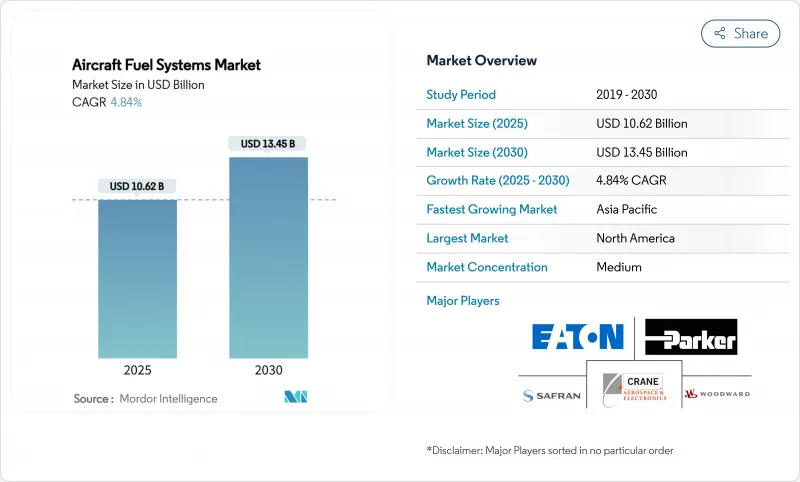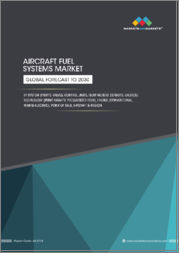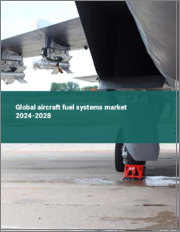
|
시장보고서
상품코드
1842527
항공기 연료 시스템 시장 : 시장 점유율 분석, 산업 동향, 통계, 성장 예측(2025-2030년)Aircraft Fuel Systems - Market Share Analysis, Industry Trends & Statistics, Growth Forecasts (2025 - 2030) |
||||||
항공기 연료 시스템 시장 규모는 2025년에 106억 2,000만 달러로 추정되고, 2030년에는 134억 5,000만 달러에 이를 것으로 예측되며, CAGR 4.84%로 견조하게 추이할 전망입니다.

항공기 생산 일정 증가, 자율성 기반 급유 프로그램, 디지털 리노베이션은 원재료 부족이 공급 연속성에 과제를 던지고 있음에도 불구하고 수요를 강화하고 있습니다. 에어버스만으로도, 2025년 5월에 A321neo와 A321XLR을 필두로 51기가 인도되어, 선진적인 연비 구조에 의존하는 단통로기의 납품이 회복되고 있는 것이 밝혀졌습니다. 이와 병행해 미국 해군이 8억 9,800만 달러를 투자해, MQ-25 스팅레이 무인 유조선 3대를 발주하고 해상에서 자율 공중 급유를 시작한 것도 기세를 늘리고 있습니다. 파커 하니핀 등 북미의 기존 기업은 2025년 3분기에 항공우주 사업 매출이 12% 증가한 16억 달러를 기록해 애프터마켓이 건전히 확대된 것을 보여주고 있습니다. 아시아태평양은 공항 인프라 확장과 국방 예산 증가를 배경으로 CAGR 5.78%를 기록하여 가장 빠른 상승을 제공합니다. 질소 삽입과 지속 가능한 항공 연료(SAF)로의 이동에 대한 규제의 주장은 인증 비용의 압력과 민간 및 군사의 밸류체인 전체에 지속되는 티타늄 공급의 혼란을 상쇄하고 기술 업그레이드를 더욱 자극합니다.
세계의 항공기 연료 시스템 시장 동향 및 인사이트
세계의 상용 항공기 납품 대수 급증
항공사는 항공사의 리노베이션 사이클에 따라 생산량을 늘리고 있습니다. 에어버스는 2025년에 820대의 납품을 목표로, 복수의 센터 탱크와 보조 탱크 배치를 이용해 최대 4,700 NM의 항속 거리를 달성하는 장거리 단통로 모델을 우선하고 있습니다. 보잉은 F-15EX 전투기의 동시 생산으로 전투 플랫폼용 연료 펌프 및 밸브 수요를 유지하고 있습니다. 따라서 부품 공급업체는 정밀 펌프, 프로브 및 트랜스퍼 밸브의 콜오프 확대에 직면하지만, MRO 공급업체는 가동률이 유통 전의 비행 시간으로 돌아가면서 소모품 교체 사이클이 빨라집니다.
군용 공중 급유 프로그램 확대
MQ-25 스팅레이는 500 해리를 넘어 15,000 파운드의 연료를 이송할 수 있는 최초의 항공모함 기반 무인 유조선으로, 내장해성 유량계와 자율적 셧오프 로직의 요건을 밀어 올리고 있습니다. 미국 공군의 KC-46A 페가수스의 확장과 유럽 연합의 인수는 멀티포인트 급유 수요를 강화하고 각각 대용량 부스트 펌프와 능동적으로 감쇠하는 붐 작동 매니폴드가 필요합니다.
새로운 연료 기술에 대한 높은 인증 및 인증 비용
새로운 수소 또는 SAF 지원 연료 시스템은 일반적으로 수년에 걸쳐 시험 캠페인과 FAA 인증 계획이 필요합니다. FAA가 2024년 12월에 발표한 수소 로드맵은 제조업체가 수백만 달러의 인증 비용을 부담할 수 있는 데이터 갭을 강조합니다. 소규모 공급업체는 시장 진입을 늦추고 가격 경쟁을 제한하는 불균형 부담에 직면하고 있습니다.
부문 분석
그라비티 피드 아키텍처는 2024년 항공기 연료 시스템 시장 점유율의 45.76%를 유지하여 일반 항공 및 일부 군용 플릿에 비용 효율적인 매력이 있음을 뒷받침합니다. 같은 기간 동안 연료 분사 플랫폼의 항공기 연료 시스템 시장 규모는 모든 유형 중에서 가장 빠른 CAGR 6.34%로 추이했습니다. 이는 실시간 혼합기 최적화를 통해 연료 소비를 약 15% 줄일 수 있는 FADEC 호환 하드웨어가 운영자에게 받아들여졌기 때문입니다. 펌프 피드 솔루션은 성능의 중간 영역을 계속 제공하고 완전한 디지털 오버레이 없이 정압 공급이 필요한 기체를 지원했습니다.
공급업체는 차세대 인젝터에 머신러닝 로직을 통합하고 유량 요구 사항을 예측하며 탱크 균형을 자율적으로 조정하여 연료 회로를 센서가 풍부한 데이터 소스로 전환합니다. 사프란의 FADEC 4는 전반적인 효율성을 높이면서 이전 유닛보다 10배 더 높은 처리 능력을 제공하여 비약적인 진보를 보여줍니다. IoT 커넥티비티가 비행 데크에 퍼지면서 기존의 중력 시스템은 보다 엄격한 소비 제어, 예측 상태 모니터링, 라이프사이클 비용 절감을 약속하는 분사 어셈블리와의 경쟁 압력에 직면하여 보다 넓은 항공기 연료 시스템 시장에서의 기술 이동을 가속화하고 있습니다.
2024년 수익 점유율은 연료 탱크가 36.58%로 가장 컸습니다. 그럼에도 불구하고, 질소 발전기, 멤브레인, 배수 배관에 걸친 불활성화 어셈블리는 강제 개조 프로그램을 배경으로 CAGR 5.78%로 전진했습니다. 불활성화 솔루션의 항공기 연료 시스템 시장 규모는 2025년에는 18억 달러에 이를 것으로 추정되고, 10년 후까지는 24억 달러를 넘을 기세입니다. 사업자는 연소 노출 컴플라이언스와 보험상의 이점을 대가로 높은 자본 비용을 받아들입니다.
가변 속도 전동 펌프와 스마트 모터 작동 밸브는 불활성 가스 주입 중에 탱크 압력을 조화시켜 안전성을 높입니다. 이 시스템은 탑재된 산소 센서와 함께 순도가 임계값을 벗어날 경우 승무원 및 유지보수 팀에 알리고 항공기 연료 시스템 시장이 실시간 데이터의 가시성을 강조하는 것을 강화하고 있습니다.
지역 분석
아시아태평양의 항공 서비스 지출은 2025년 520억 달러에서 2043년 1,290억 달러로 증가하여 복합 성장률 4.81%로 성장할 것을 의미하며, 연료 시스템 예비품도 비례하여 증가합니다. 유지보수 비용만으로도 연률 5.0%로 가속하여 예측 분석 라이센서나 특수 씰 제조업체를 위한 공간이 생깁니다. 중국의 민간 사업 확대는 국산 와이드 바디 프로그램과 제휴하여 티탄제 탱크 피팅의 국산화를 추진합니다. 인도의 SAF 추진은 2030년까지의 듀얼 연료 대응 씰의 필요성을 강조하고, 싱가포르는 2026년부터 조기의 1% SAF 혼합 룰에 의해 필터 적응성이 살아있는 실험대가 되고 있습니다.
북미의 42.35% 시장 점유율은 캔자스, 워싱턴, 조지아에 퍼져 있는 정착된 OEM 및 MRO 생태계에서 비롯됩니다. 미 공군은 F-15EX와 KC-46A의 주문을 계속하고 있으며, 밸브, 펌프, 호스 조달은 2030년까지 안정적으로 성장할 전망입니다. FAA(Federal Authority)의 가연성 의무화는 질소 생성 및 모니터링 라인의 리노베이션 작업 범위를 더욱 확대합니다.
유럽은 환경 규제에서 우위를 유지하고 있습니다. ReFuelEU 항공법은 2025년까지 2%의 SAF로 시작하여 2050년까지 70%까지 확대되어 용해도가 높은 바이오 유래 연료를 위한 필터 하우징의 재설계를 강요합니다. Airbus와 Total Energys의 파트너십은 2030년까지 연간 150만 톤의 SAF 생산을 목표로 하며 새로운 연료 화학물질을 견딜 수 있는 노즐, 개스킷 및 씰 수요를 지원합니다.
기타 혜택 :
- 엑셀 형식 시장 예측(ME) 시트
- 3개월의 애널리스트 서포트
목차
제1장 서론
- 조사의 전제조건 및 시장 정의
- 조사 범위
제2장 조사 방법
제3장 주요 요약
제4장 시장 상황
- 시장 개요
- 시장 성장 촉진요인
- 세계의 상용 항공기 납입수 급증
- 군용 공중 급유 프로그램의 확대
- 저연비 플랫폼으로의 급속한 기체 근대화
- 민간 및 방위 분야에서 UAV 조달 증가
- 연료 시스템의 건전성을 실시간으로 파악하기 위한 예측 분석 통합
- 안전을 위한 질소 불활성화 시스템의 복고풍 의무화
- 시장 성장 억제요인
- 새로운 연료 기술에 대한 높은 인증 및 인정 비용
- 항공급 티타늄 및 엘라스토머 공급 병목
- 연료 가격 변동으로 인한 항공사 설비 투자 억제
- 디지털 계측 및 제어 네트워크에서 사이버 보안 위험
- 밸류체인 분석
- 규제 상황
- 기술적 전망
- Porter's Five Forces 분석
- 신규 참가업체의 위협
- 구매자 및 소비자의 협상력
- 공급기업의 협상력
- 대체품의 위협
- 경쟁 기업간 경쟁 관계의 강도
제5장 시장 규모 및 성장 예측
- 유형별
- 그라비티 피드
- 펌프 피드
- 연료 분사 시스템
- 컴포넌트별
- 연료 탱크
- 연료 펌프
- 밸브와 매니폴드
- 게이지 및 센서
- 불활성화 시스템
- 연료 필터
- 항공기 클래스별
- 상용 항공기
- 내로우 바디 항공기
- 와이드 바디 기계
- 지역 기계
- 군용기
- 전투기
- 비전투기
- 헬리콥터
- 일반 여객기
- 비즈니스 제트기
- 터보프롭기
- 피스톤 항공기
- 헬리콥터
- 무인 항공기(UAVs)
- 상용 항공기
- 최종 용도별
- OEM
- 애프터마켓
- 기술별
- 종래의 기계 시스템
- FADEC 통합 전기 시스템
- 불활성화 시스템
- 스마트 및 커넥티드 연료 시스템
- 지역별
- 북미
- 미국
- 캐나다
- 멕시코
- 유럽
- 영국
- 독일
- 프랑스
- 러시아
- 기타 유럽
- 아시아태평양
- 중국
- 인도
- 일본
- 한국
- 기타 아시아태평양
- 남미
- 브라질
- 기타 남미
- 중동 및 아프리카
- 중동
- 아랍에미리트(UAE)
- 사우디아라비아
- 튀르키예
- 기타 중동
- 아프리카
- 이집트
- 남아프리카
- 기타 아프리카
- 북미
제6장 경쟁 구도
- 시장의 집중
- 전략적인 동향
- 시장 점유율 분석
- 기업 프로파일
- Eaton Corporation plc
- Parker-Hannifin Corporation
- Safran SA
- Crane Aerospace & Electronics(Crane Company)
- Woodward, Inc.
- RTX Corporation
- GKN Aerospace Services Limited(Melrose plc)
- Triumph Group Inc.
- SECONDO MONA SpA
- Honeywell International Inc.
- Robertson Fuel Systems, LLC(HEICO Corporation)
- Marshall of Cambridge(Holdings) Ltd
- Weldon Pump. LLC.
제7장 시장 기회 및 전망
AJY 25.10.29The aircraft fuel systems market size stands at USD 10.62 billion in 2025 and is forecasted to reach USD 13.45 billion by 2030, translating into a steady 4.84% CAGR.

Heightened aircraft production schedules, autonomy-driven refueling programs, and digital retrofits reinforce demand even as raw-material shortages challenge supply continuity. Airbus alone handed over 51 aircraft in May 2025, led by the A321neo and A321XLR, underscoring a rebound in single-aisle deliveries that depend on advanced fuel-saving architectures. Parallel momentum stems from a USD 898 million US Navy order covering three MQ-25 Stingray unmanned tankers, inauguring autonomous aerial refueling at sea. North American incumbents such as Parker Hannifin recorded 12% aerospace revenue growth to USD 1.6 billion in Q3 2025, signalling healthy aftermarket pull-through. Asia-Pacific provides the fastest regional lift, posting a 5.78% CAGR on the back of airport infrastructure expansion and rising defence budgets. Regulatory insistence on nitrogen-inerting and shifting toward sustainable aviation fuels (SAF) further stimulates technology upgrades, offsetting certification cost pressures and titanium supply disruptions that persist across civil and military value chains.
Global Aircraft Fuel Systems Market Trends and Insights
Surging Global Commercial Aircraft Deliveries
Airframers are elevating output to meet airline refurbishment cycles. Airbus aims for 820 deliveries in 2025 and prioritizes long-range single-aisle models that utilise multiple centre- and auxiliary-tank arrangements to achieve up to 4,700 NM range. Boeing's concurrent production of F-15EX fighters sustains fuel pump and valve demand for combat platforms. Component suppliers, therefore, face enlarged call-offs for precision pumps, probes, and transfer valves while MRO providers register faster consumable replacement cycles as utilization returns to pre-pandemic flight hours.
Expansion of Military Aerial-Refueling Programs
The MQ-25 Stingray marks the first carrier-based unmanned tanker capable of transferring 15,000 lb of fuel beyond 500 NM, pushing requirements for fault-tolerant flow metering and autonomous shut-off logic. The USAF's KC-46A Pegasus expansion and allied European acquisitions reinforce multi-point refuelling demand, each necessitating high-capacity boost pumps and actively damped boom-actuation manifolds.
High Certification and Qualification Costs for New Fuel Technologies
Novel hydrogen or SAF-ready fuel systems routinely require multi-year test campaigns and FAA certification plans. The agency's December 2024 Hydrogen Roadmap highlights data gaps that could cost manufacturers tens of millions in qualification expenditure. Small suppliers face disproportionate burdens that slow market entry and limit price competition.
Other drivers and restraints analyzed in the detailed report include:
- Rapid Fleet Modernization Toward Fuel-Efficient Platforms
- Predictive Analytics Integration for Real-Time Fuel-System Health
- Aviation-Grade Titanium and Elastomer Supply Bottlenecks
For complete list of drivers and restraints, kindly check the Table Of Contents.
Segment Analysis
Gravity-feed architectures retained 45.76% of the aircraft fuel systems market share in 2024, underscoring their cost-effective appeal for general aviation and selected military fleets. Within the same period, the aircraft fuel systems market size for fuel-injection platforms advanced at a 6.34% CAGR, the fastest among all types, as operators embraced FADEC-compatible hardware that can trim fuel burn by about 15% through real-time mixture optimization. Pump-feed solutions continued to serve the performance middle ground, supporting airframes that require positive pressure delivery without the full digital overlay.
Suppliers are embedding machine-learning logic into next-gen injectors to predict flow requirements and balance tanks autonomously, turning the fuel circuit into a sensor-rich data source. Safran's FADEC 4 illustrates the leap, delivering 10 times greater processing power than earlier units while elevating overall efficiency. As IoT connectivity spreads across flight decks, traditional gravity systems face competitive pressure from injection assemblies that promise tighter consumption control, predictive health monitoring, and lower lifecycle cost, accelerating the technology shift within the broader aircraft fuel systems market.
Fuel tanks held the largest 36.58% revenue share in 2024. Nonetheless, inerting assemblies-spanning nitrogen generators, membranes, and distribution plumbing-advanced at a 5.78% CAGR on the back of mandatory retrofit programs. The aircraft fuel systems market size for inerting solutions stood near USD 1.8 billion in 2025 and is on track to exceed USD 2.4 billion by decade-end. Operators accept higher capital costs in exchange for flammability-exposure compliance and insurance benefits.
Variable-speed electric pumps and smart motor-operated valves augment safety by harmonising tank pressures during inert gas injection. Coupled with embedded oxygen sensors, these systems notify crews or maintenance teams when purity drifts outside thresholds, reinforcing the aircraft fuel systems market's emphasis on real-time data visibility.
The Aircraft Fuel Systems Market Report is Segmented by Type (Gravity Feed, Pump Feed, and Fuel Injection Systems), Component (Fuel Tanks, Fuel Pumps, and More), Aircraft Class (Commercial Aircraft, Military Aircraft, and More), End Use (OEM and Aftermarket), Technology (Conventional Mechanical Systems, and More), and Geography (North America, Europe, and More). The Market Forecasts are Provided in Terms of Value (USD).
Geography Analysis
Asia-Pacific's aviation services outlay will rise from USD 52 billion in 2025 to USD 129 billion in 2043, implying compound 4.81% growth and a proportional uptick in fuel system spares. Maintenance spend alone accelerates at 5.0% yearly, creating space for predictive analytics licensors and specialty seal manufacturers. China's civil expansion partners with indigenous wide-body programs, pushing the localization of titanium tank fittings. India's SAF push underlines the need for dual-fuel-compatible seals by 2030, while Singapore's early 1% SAF blending rule from 2026 makes it a live testbed for filter adaptability.
North America's 42.35% market share derives from entrenched OEM and MRO ecosystems across Kansas, Washington, and Georgia. The USAF continues to order the F-15EX and KC-46A, locking in steady valve, pump, and hose procurements through 2030. FAA flammability mandates further generate retrofit workscopes for nitrogen generation and monitoring lines.
Europe maintains primacy in environmental regulation. The ReFuelEU Aviation Act begins with 2% SAF by 2025 and scales to 70% by 2050, compelling filter-housing redesigns for bio-derived fuels with higher solvency. Airbus' partnership with TotalEnergies targets 1.5 million t annual SAF output by 2030, underpinning nozzle, gasket, and seal demand that can withstand novel fuel chemistries.
- Eaton Corporation plc
- Parker-Hannifin Corporation
- Safran SA
- Crane Aerospace & Electronics (Crane Company)
- Woodward, Inc.
- RTX Corporation
- GKN Aerospace Services Limited (Melrose plc)
- Triumph Group Inc.
- SECONDO MONA S.p.A.
- Honeywell International Inc.
- Robertson Fuel Systems, LLC (HEICO Corporation)
- Marshall of Cambridge (Holdings) Ltd
- Weldon Pump. LLC.
Additional Benefits:
- The market estimate (ME) sheet in Excel format
- 3 months of analyst support
TABLE OF CONTENTS
1 INTRODUCTION
- 1.1 Study Assumptions and Market Definition
- 1.2 Scope of the Study
2 RESEARCH METHODOLOGY
3 EXECUTIVE SUMMARY
4 MARKET LANDSCAPE
- 4.1 Market Overview
- 4.2 Market Drivers
- 4.2.1 Surging global commercial aircraft deliveries
- 4.2.2 Expansion of military aerial-refueling programs
- 4.2.3 Rapid fleet modernization toward fuel-efficient platforms
- 4.2.4 Rising UAV procurement across civil and defense sectors
- 4.2.5 Predictive analytics integration for real-time fuel-system health
- 4.2.6 Mandatory retrofit of nitrogen-inerting systems for safety
- 4.3 Market Restraints
- 4.3.1 High certification and qualification costs for new fuel technologies
- 4.3.2 Aviation-grade titanium and elastomer supply bottlenecks
- 4.3.3 Fuel-price volatility curbing airline capital expenditure
- 4.3.4 Cyber-security risks in digital gauging and control networks
- 4.4 Value Chain Analysis
- 4.5 Regulatory Landscape
- 4.6 Technological Outlook
- 4.7 Porter's Five Forces Analysis
- 4.7.1 Threat of New Entrants
- 4.7.2 Bargaining Power of Buyers/Consumers
- 4.7.3 Bargaining Power of Suppliers
- 4.7.4 Threat of Substitute Products
- 4.7.5 Intensity of Competitive Rivalry
5 MARKET SIZE AND GROWTH FORECASTS (VALUE)
- 5.1 By Type
- 5.1.1 Gravity Feed
- 5.1.2 Pump Feed
- 5.1.3 Fuel Injection Systems
- 5.2 By Component
- 5.2.1 Fuel Tanks
- 5.2.2 Fuel Pumps
- 5.2.3 Valves and Manifolds
- 5.2.4 Gauges and Sensors
- 5.2.5 Inerting Systems
- 5.2.6 Fuel Filters
- 5.3 By Aircraft Class
- 5.3.1 Commercial Aircraft
- 5.3.1.1 Narrowbody Aircraft
- 5.3.1.2 Widebody Aircraft
- 5.3.1.3 Regional Aircraft
- 5.3.2 Military Aircraft
- 5.3.2.1 Combat Aircraft
- 5.3.2.2 Non-Combat Aircraft
- 5.3.2.3 Helicopters
- 5.3.3 General Aviation Aircraft
- 5.3.3.1 Business Jets
- 5.3.3.2 Turboprop Aircraft
- 5.3.3.3 Piston Aircraft
- 5.3.3.4 Helicopters
- 5.3.4 Unmanned Aerial Vehicles (UAVs)
- 5.3.1 Commercial Aircraft
- 5.4 By End Use
- 5.4.1 OEM
- 5.4.2 Aftermarket
- 5.5 By Technology
- 5.5.1 Conventional Mechanical Systems
- 5.5.2 FADEC-Integrated Electric Systems
- 5.5.3 Inerting-Enabled Systems
- 5.5.4 Smart/Connected Fuel Systems
- 5.6 By Geography
- 5.6.1 North America
- 5.6.1.1 United States
- 5.6.1.2 Canada
- 5.6.1.3 Mexico
- 5.6.2 Europe
- 5.6.2.1 United Kingdom
- 5.6.2.2 Germany
- 5.6.2.3 France
- 5.6.2.4 Russia
- 5.6.2.5 Rest of Europe
- 5.6.3 Asia-Pacific
- 5.6.3.1 China
- 5.6.3.2 India
- 5.6.3.3 Japan
- 5.6.3.4 South Korea
- 5.6.3.5 Rest of Asia-Pacific
- 5.6.4 South America
- 5.6.4.1 Brazil
- 5.6.4.2 Rest of South America
- 5.6.5 Middle East and Africa
- 5.6.5.1 Middle East
- 5.6.5.1.1 United Arab Emirates
- 5.6.5.1.2 Saudi Arabia
- 5.6.5.1.3 Turkey
- 5.6.5.1.4 Rest of Middle East
- 5.6.5.2 Africa
- 5.6.5.2.1 Egypt
- 5.6.5.2.2 South Africa
- 5.6.5.2.3 Rest of Africa
- 5.6.1 North America
6 COMPETITIVE LANDSCAPE
- 6.1 Market Concentration
- 6.2 Strategic Moves
- 6.3 Market Share Analysis
- 6.4 Company Profiles (includes Global level Overview, Market level overview, Core Segments, Financials as available, Strategic Information, Market Rank/Share for key companies, Products and Services, and Recent Developments)
- 6.4.1 Eaton Corporation plc
- 6.4.2 Parker-Hannifin Corporation
- 6.4.3 Safran SA
- 6.4.4 Crane Aerospace & Electronics (Crane Company)
- 6.4.5 Woodward, Inc.
- 6.4.6 RTX Corporation
- 6.4.7 GKN Aerospace Services Limited (Melrose plc)
- 6.4.8 Triumph Group Inc.
- 6.4.9 SECONDO MONA S.p.A.
- 6.4.10 Honeywell International Inc.
- 6.4.11 Robertson Fuel Systems, LLC (HEICO Corporation)
- 6.4.12 Marshall of Cambridge (Holdings) Ltd
- 6.4.13 Weldon Pump. LLC.
7 MARKET OPPORTUNITIES AND FUTURE OUTLOOK
- 7.1 White-space and Unmet-Need Assessment













